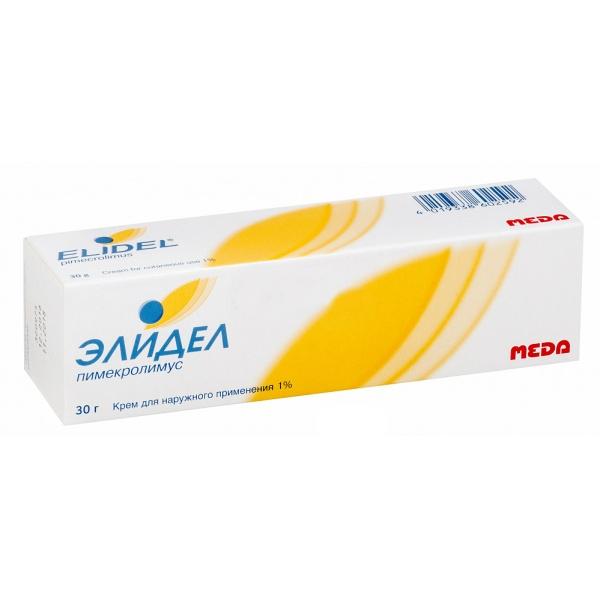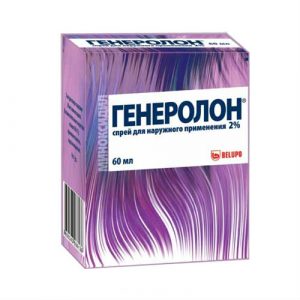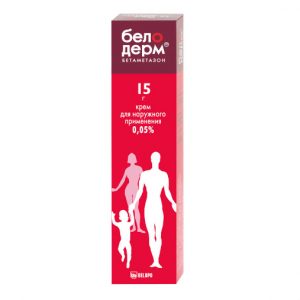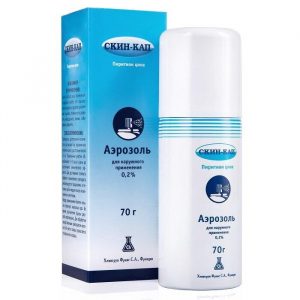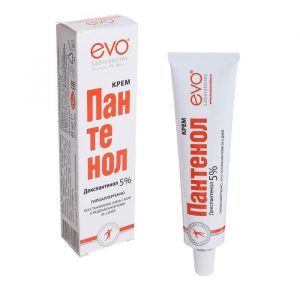Description
Release form
Cream for external use.
Pharmacological action
Pimecrolimus is a derivative of macrolactam ascomycin. Selectively inhibits the production and release of cytokines and mediators from T-lymphocytes and mast cells. It has anti-inflammatory properties.
Pimecrolimus specifically binds to macrophilin-12 and inhibits calcium-dependent phosphine phosphatase calcineurin. As a result, by blocking the transcription of early cytokines, pimecrolimus inhibits the activation of T-lymphocytes. In particular, at nanomolar concentrations, pimecrolimus inhibits the synthesis of interleukin-2, interferon gamma (Th1 type), interleukin-4 and interleukin-10 (Th2 type) in human T-lymphocytes. In addition, in vitro after interaction with the antigen / IgE complex, pimecrolimus prevents antigen / IgE-mediated release of cytokines and inflammatory mediators from mast cells. Pimecrolimus does not affect the growth of keratinocytes, fibroblasts and endothelial cells.
Pimecrolimus is effective for skin inflammation, while its effect on the systemic immune response is very slight. In general, the uniqueness of the mechanism of action of pimecrolimus lies in the combination of anti-inflammatory activity, selective for skin, with a low ability to induce systemic immune responses.
Indications
Atopic dermatitis (eczema).
The drug is indicated for short-term and long-term treatment of atopic dermatitis in adults, adolescents and children (from 3 months).
Contraindications
Hypersensitivity to pimecrolimus or any components of the drug.
Children under 3 months of age (because the safety and effectiveness of Elidel cream in children under 3 months of age has not been studied).
Elidel cream should not be applied to areas of the skin affected by acute viral, bacterial or fungal infections.
Caution:
There is no data on the safety of using Elidel cream in patients with Netherton’s syndrome and generalized erythroderma. Given the possible risk of increased systemic absorption of the drug, Elidel cream is not recommended for use in patients with Netherton’s syndrome or in severe forms of inflammation or skin damage (for example, with erythroderma).
Since the effectiveness and safety of using Elidel cream in immunocompromised patients has not been studied, the drug is not recommended for use in this category of patients.
Safety data for prolonged use of Elidel cream is not available.
Since the effect of prolonged use of the drug on the immune defense of the skin and the incidence of malignant neoplasms has not been studied, Elidel cream should not be applied to damaged areas of the skin with possible malignancy or dysplastic changes.
In the case of bacterial or fungal skin lesions, the use of Elidel cream in the affected areas is possible only after the infection has been cured.
Use during pregnancy and lactation
Pregnancy. There are no data on the use of 1% Elidel cream in pregnant women. In experimental studies with topical use of the drug, the direct or indirect damaging effect of Elidel on pregnancy, the development of the embryo / fetus, the course of childbirth and the postnatal development of offspring was not detected.
Caution should be exercised when prescribing 1% Elidel Cream for pregnant women. However, given the minimal degree of absorption of pimecrolimus when applied topically, the potential risk in humans is considered negligible.
Lactation. Isolation of the drug with breast milk after topical application in experimental models has not been studied. There are no data on the content of pimecrolimus in breast milk in nursing women. Since many drugs are excreted in breast milk, care should be taken when prescribing 1% Elidel cream to lactating women. However, given the minimal degree of systemic absorption of pimecrolimus when applied topically, the potential risk to humans is considered negligible.
Nursing women should not apply 1% Elidel cream to the area of the mammary glands.
Special instructions
In the treatment of topical calcineurin inhibitors, including Elidel, the development of malignant neoplasms (for example, skin tumors and lymphomas) has been noted in rare cases. A causal relationship between these adverse events and the use of the drug has not been established.
In clinical trials with the use of Elidel cream, 0.9% of patients (14 of 1544) showed the development of lymphadenopathy. Typically, lymphadenopathy was caused by infectious diseases and disappeared after a course of appropriate antibiotic therapy. In all patients, either it was possible to identify the cause of the development of lymphadenopathy or the disappearance of this undesirable phenomenon was noted. In patients receiving treatment with Elidel, with the development of lymphadenopathy, it is necessary to establish the etiology of the process and ensure that patients are monitored until this undesirable phenomenon completely disappears. If the etiology of lymphadenopathy is unknown or if the patient has acute mononucleosis, the drug should be discontinued.
When treating with Elidel Cream, patients are advised to minimize artificial or natural insolation of the skin or to completely avoid ultraviolet radiation. The possible effect of the use of the drug in skin lesions caused by ultraviolet radiation is unknown.
Effect on the ability to drive a car and work with mechanisms
The effect of using Elidel cream on the ability to drive vehicles or work with mechanisms has not been established.
Composition of
1 g of cream contains pimecrolimus – 10 mg srdlp substances hydroxide 0.20 mg, citric acid anhydrous 0, 50 mg, benzyl alcohol 10.00 mg, sodium cetostearyl sulfate 10.00 mg, mono and diglycerides 20.00 mg, cetyl alcohol 40.00 mg, stearic alcohol 40.00 mg, propylene glycol 50.00 mg, oleyl alcohol 100.00 mg, medium chain triglycerides 150.00 mg, purified water 569.30 mg.
Dosage and administration of
Treatment should be started at the first manifestations of the disease to prevent a sharp development of its exacerbation.
1% Elidel cream 2 times a day is applied in a thin layer on the affected surface and gently rubbed until completely absorbed.
1% Elidel cream can be applied to the skin of any part of the body, including the head, face, neck, as well as the diaper rash area.
Elidel cream should be used 2 times a day, until the symptoms disappear completely. While maintaining the severity of symptoms after 6 weeks of use of the drug, it is necessary to re-examine the patient to confirm the diagnosis of atopic dermatitis. After stopping treatment, in order to avoid subsequent exacerbations, at the first signs of a relapse of atopic dermatitis, therapy should be resumed.
Emollients can be used immediately after applying 1% Elidel cream. However, after water procedures, emollients should be used before applying Elidel cream.
Given the very slight systemic absorption of pimecrolimus, there are no restrictions on the total daily dose of the drug applied, the area of the treated surface of the skin, or the duration of treatment.
Side effects
Application of 1% Elidel cream may cause minor transient reactions at the application site, such as a feeling of warmth and / or burning. With a significant severity of these reactions, patients should consult a doctor.
The most common adverse events – reactions at the site of application of the drug were observed in 19% of patients treated with 1% Elidel cream, and in 16% of patients from the control group. These reactions mainly occurred at an early stage of treatment, were insignificant / moderate and short-lived.
The following adverse events are listed in frequency, starting with the most common. The frequency of adverse reactions was evaluated as follows: occurring very often -> 1/10, often -> 1/100 <1/10, sometimes -> 1/1000 <1/100, rarely -> 1/10 000 <1/1000, very rarely - <1/10 000, including individual messages. Very often: a burning sensation at the place of application of the cream. Often: local reactions (irritation, itching and redness of the skin), skin infections (folliculitis). Sometimes: suppuration worsening of the disease herpes simplex dermatitis due to herpes simplex virus (herpes eczema) molluscum contagiosum, local reactions such as rash, pain, paresthesia, desquamation, dryness, swelling, skin papillomas, boils. The following adverse reactions were noted with post-marketing use of the drug (an estimate of the frequency of the number of cases of AE in an unidentified population). From the side of the immune system: very rarely – anaphylactic reactions. From the side of metabolism (metabolic disorders): rarely – intolerance to alcohol. From the skin and its appendages: rarely allergic reactions (rash, urticaria, angioedema) changes in skin color (hypopigmentation, hyperpigmentation). In most cases, redness of the face, rash, burning, itching, or swelling developed immediately after taking alcohol. When applying Elidel cream in rare cases, the development of malignant neoplasms was noted, including skin and other types of lymphomas, skin cancer. A causal relationship between these adverse events and the use of the drug has not been established. Drug Interactions Potential interactions of 1% Elidel Cream with other drugs have not been studied. Given that the systemic absorption of pimecrolimus is very small, any interactions of Elidel cream with drugs for systemic use are unlikely. When using Elidel cream in children aged 2 years and older, the drug did not affect the effectiveness of vaccination. It is not recommended to apply the cream to the vaccine administration area until the local manifestations of the post-vaccination reaction completely disappear. Incompatibility Since compatibility studies have not been conducted, it is not recommended to use the drug in conjunction with other local agents. Overdose There were no cases of overdose or accidental use of 1% Elidel cream. Storage conditions Do not store above 25 ° C, do not freeze. The drug should be stored out of the reach of children. Shelf life 2 years. The drug should not be used after the expiration date. After the first autopsy, use within 1 year. Deystvuyushtee substance pimecrolimus Pharmacy terms Prescription dosage form cream Prescribed Prescribed by Adults prescribed by a doctor, Pregnant as prescribed by a doctor, Children older than 3 yatsev, nursing mothers, children on doctor’s prescription
